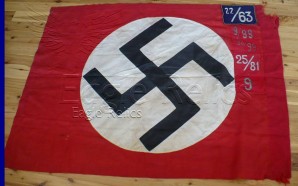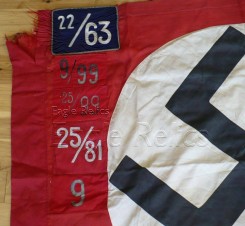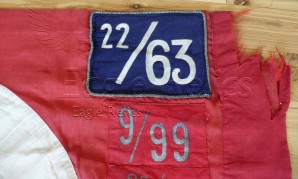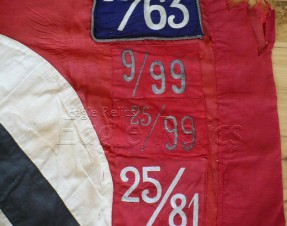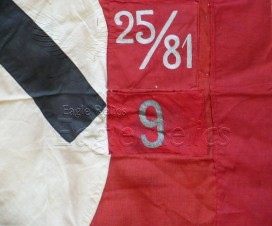Early “thin Swastika” Storm Flag
Stock No. 71006
Product Information
Out of Stock
An early flag that just shouts history….. This “thin swastika” flag has 5 traditions patches on each side. It is multi piece construction and in great condition. At some point I think it has been torn and then repaired, and possibly framed….. But it is a rare piece of 3rd Reich history – I will take more pictures if required
The 9 was the first unit to which this flag was granted. A specific date I cannot find, but may have been 1931 and may have existed at the Pommern-district or Mitte; the flag was transferred to 25/81 in 1932, which is Frankfurt/Main in Hessenand and was part for brigade 49. It is possible 81 existed first at the West-district, c) in about early 1933 the flag then was transferred to 25/99 and later 9/99, being Hattingen in Westfalen. The constant transferring was caused by the many SA re-organizations and districts-corrections in the years 1932 and 1933; in about mid-1933 the flag must have been again transferred, but now to 22/63which is Frankfurt/Main in Hessen again, being a part for brigade 49. It remained in brigade 49 until mid-war.
Standarte 63 was based in Frankfurt a.Main
Every Sturmfahne was supposed to be ‘consecrated’ by touching it to the related Deutschland Erwache Standard, which would have been touched to the Blood Flag. So, the Sturmfahnen were not just flags, but were considered to have a direct connection to the Blood Flag, and thus, in a mystical 3rd Reich way, to the martyrs of 9. November 1923. You can see, in period photos, SA Sturmfahnen of various types with earlier or later proportions, variant pole connections, of slightly varying size, with or without fringe, etc. , paraded together during SA and NSDAP events.
These flags were sent to either the NSKK high command or RZM to be resewn, have insignia removed or added, or whatever else needed to be done. The flags themselves were not replaced or discarded but continued to be used after they were modified to be regulation compliant.
Along with SA Standarte 81, St 63 was responsible for south Hessia’s first concentration camp that opened in May 1933 in an old factory, the so-called “Perlenfabrik” in FFM-Ginnheim. The camp became known for the torture and cruelty of the SA men who mistreated the prisoners, mostly communists and union members, who were initially incarcerated there. Eventually, the camp got so crowded that it was necessary to open others in the Frankfurt area to accommodate the overflow.
Later, in October 1941, SA Standarte 63 was given the task of rounding up Jewish residents of Frankfurt’s Westend district for deportation. The special action turned into confusion when the Gestapo didn’t show up in time to seal the apartments of the evicted Jews and move the people to collection points. Subsequently, the hundreds of Jews were marched through the city.
It has a few old moth holes



